
Fornax is a constellation in the southern celestial hemisphere, partly ringed by the celestial river Eridanus. Its name is Latin for furnace. It was named by French astronomer Nicolas Louis de Lacaille in 1756. Fornax is one of the 88 modern constellations.

Coma Berenices is an ancient asterism in the northern sky, which has been defined as one of the 88 modern constellations. It is in the direction of the fourth galactic quadrant, between Leo and Boötes, and it is visible in both hemispheres. Its name means "Berenice's Hair" in Latin and refers to Queen Berenice II of Egypt, who sacrificed her long hair as a votive offering. It was introduced to Western astronomy during the third century BC by Conon of Samos and was further corroborated as a constellation by Gerardus Mercator and Tycho Brahe. It is the only modern constellation named for a historic person.

Cassiopeia is a constellation and asterism in the northern sky named after the vain queen Cassiopeia, mother of Andromeda, in Greek mythology, who boasted about her unrivaled beauty. Cassiopeia was one of the 48 constellations listed by the 2nd-century Greek astronomer Ptolemy, and it remains one of the 88 modern constellations today. It is easily recognizable due to its distinctive 'W' shape, formed by five bright stars.

Messier 38 or M38, also known as NGC 1912 or Starfish Cluster, is an open cluster of stars in the constellation of Auriga. It was discovered by Giovanni Batista Hodierna before 1654 and independently found by Le Gentil in 1749. The open clusters M36 and M37, also discovered by Hodierna, are often grouped together with M38. Distance is about 1.066 kpc (3,480 ly) away from Earth. The open cluster NGC 1907 lies nearby on the sky, but the two are most likely just experiencing a fly-by, having originated in different parts of the galaxy.
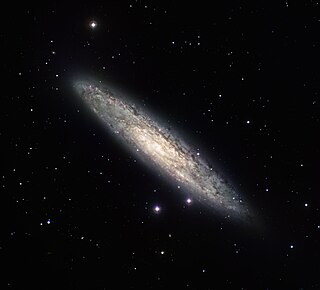
The Sculptor Galaxy is an intermediate spiral galaxy in the constellation Sculptor. The Sculptor Galaxy is a starburst galaxy, which means that it is currently undergoing a period of intense star formation.

NGC 206 is a bright star cloud in the Andromeda Galaxy, and the brightest star cloud in Andromeda when viewed from Earth.

NGC 1316 is a lenticular galaxy about 60 million light-years away in the constellation Fornax. It is a radio galaxy and at 1400 MHz is the fourth-brightest radio source in the sky.
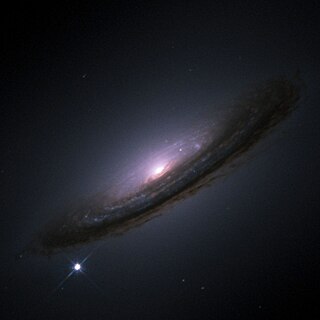
NGC 4526 is a lenticular galaxy with an embedded dusty disc, located approximately 55 million light-years from the Solar System in the Virgo constellation and discovered on 13 April 1784 by William Herschel.

NGC 4945 (also known as Caldwell 83) is a barred spiral galaxy in the constellation Centaurus, visible near the star Xi Centauri. The galaxy was discovered by James Dunlop in 1826 and is thought to be similar to the Milky Way Galaxy, although X-ray observations show that NGC 4945 has an unusual energetic Seyfert 2 nucleus that might house a supermassive black hole. Around the nucleus of the galaxy, there is a dense disk of dust and gas, along with many dense star clusters. This object has an estimated mass of 1.4+1.4
−0.7×1011 M☉.

NGC 6530 is a young open cluster of stars in the southern constellation of Sagittarius, located some 4,300 light years from the Sun. It exists within the H II region known as the Lagoon Nebula, or Messier 8, and spans an angular diameter of 14.0′. The nebulosity was first discovered by G. B. Hodierna prior to 1654, then re-discovered by J. Flamsteed circa 1680. It was P. Loys who classified it as a cluster in 1746, as he could only resolve stars. The following year, G. Le Gentil determined it was both a nebula and a cluster.
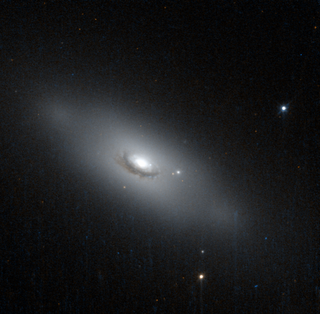
NGC 1260 is a spiral or lenticular galaxy in the constellation Perseus. It was discovered by astronomer Guillaume Bigourdan on 19 October 1884. NGC 1260 is a member of the Perseus Cluster and forms a tight pair with the galaxy PGC 12230. In 2006, it was home to the second brightest supernova in the observable universe, supernova SN 2006gy.

NGC 637 is an open cluster of stars in the northern constellation of Cassiopeia, positioned about 1.5° to the WNW of the star Epsilon Cassiopeiae. The cluster was discovered on 9 November 1787 by German-born English astronomer William Herschel. It is located in the Perseus Arm of the Milky Way, at a distance of approximately 7.045 kilolight-years from the Sun. The cluster is small but compact, and is readily visible in a small telescope.
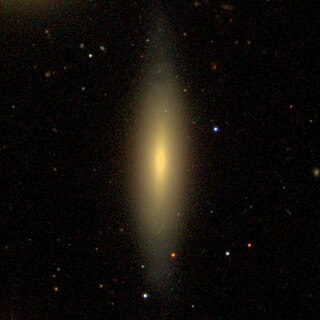
NGC 4550 is a barred lenticular galaxy located in the constellation of Virgo that can be seen with amateur telescopes. It lies at a distance of 50 million light-years from the Milky Way and is a member of the Virgo Cluster.
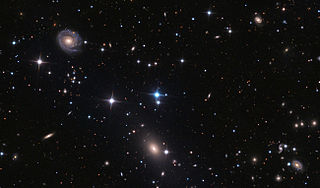
NGC 6086 is an elliptical galaxy in the constellation of Corona Borealis. It has an apparent magnitude of 12.7. A Type-cD galaxy, it is the brightest cluster galaxy in the cluster Abell 2162. In 2010, a supermassive black hole was discovered in NGC 6086.

NGC 6047 is an elliptical galaxy located about 430 million light-years away in the constellation Hercules. It was discovered by astronomer Lewis Swift on June 27, 1886. NGC 6047 is a member of the Hercules Cluster.

NGC 708 is an elliptical galaxy located 240 million light-years away in the constellation Andromeda and was discovered by astronomer William Herschel on September 21, 1786. It is classified as a cD galaxy and is the brightest member of Abell 262. NGC 708 is a weak FR I radio galaxy and is also classified as a type 2 Seyfert galaxy.
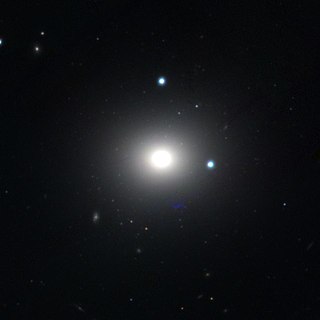
NGC 1395 is an elliptical galaxy located in the constellation Eridanus. It is located at a distance of circa 75 million light years from Earth, which, given its apparent dimensions, means that NGC 1395 is about 130,000 light years across. It was discovered by William Herschel on November 17, 1784. It is a member of the Eridanus Cluster.

NGC 753 is a spiral galaxy located 220 million light-years away in the constellation Andromeda. The galaxy was discovered by astronomer by Heinrich d'Arrest on September 16, 1865 and is a member of Abell 262.

NGC 4065 is an elliptical galaxy located 300 million light-years away in the constellation Coma Berenices. The galaxy was discovered by astronomer William Herschel on April 27, 1785. It was then rediscovered by John Herschel on April 29, 1832 and was listed as NGC 4057. NGC 4065 is the brightest member of the NGC 4065 Group.
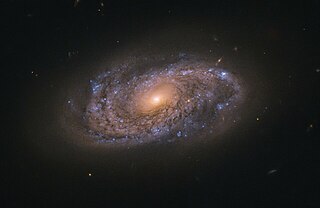
NGC 2906 is a spiral galaxy located in the constellation Leo. It is located at a distance of circa 120 million light years from Earth, which, given its apparent dimensions, means that NGC 2906 is about 75,000 light years across. It was discovered by William Herschel on December 28, 1785.





















